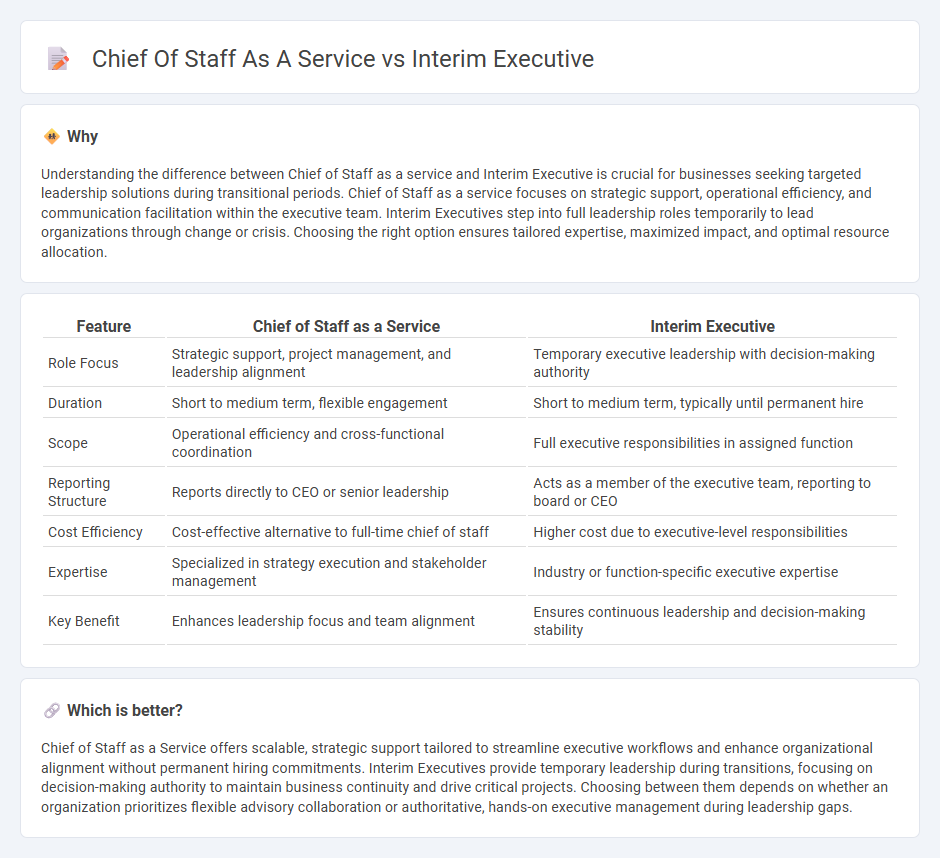
Chief of Staff as a Service provides strategic support and operational oversight tailored to enhance executive decision-making and company alignment during periods of growth or transformation. Interim Executives offer leadership continuity by temporarily filling senior management roles to address immediate business challenges or transitions. Explore how these consulting solutions can drive your organization's success with specialized expertise and flexible engagement models.
Why it is important
Understanding the difference between Chief of Staff as a service and Interim Executive is crucial for businesses seeking targeted leadership solutions during transitional periods. Chief of Staff as a service focuses on strategic support, operational efficiency, and communication facilitation within the executive team. Interim Executives step into full leadership roles temporarily to lead organizations through change or crisis. Choosing the right option ensures tailored expertise, maximized impact, and optimal resource allocation.
Comparison Table
| Feature | Chief of Staff as a Service | Interim Executive |
|---|---|---|
| Role Focus | Strategic support, project management, and leadership alignment | Temporary executive leadership with decision-making authority |
| Duration | Short to medium term, flexible engagement | Short to medium term, typically until permanent hire |
| Scope | Operational efficiency and cross-functional coordination | Full executive responsibilities in assigned function |
| Reporting Structure | Reports directly to CEO or senior leadership | Acts as a member of the executive team, reporting to board or CEO |
| Cost Efficiency | Cost-effective alternative to full-time chief of staff | Higher cost due to executive-level responsibilities |
| Expertise | Specialized in strategy execution and stakeholder management | Industry or function-specific executive expertise |
| Key Benefit | Enhances leadership focus and team alignment | Ensures continuous leadership and decision-making stability |
Which is better?
Chief of Staff as a Service offers scalable, strategic support tailored to streamline executive workflows and enhance organizational alignment without permanent hiring commitments. Interim Executives provide temporary leadership during transitions, focusing on decision-making authority to maintain business continuity and drive critical projects. Choosing between them depends on whether an organization prioritizes flexible advisory collaboration or authoritative, hands-on executive management during leadership gaps.
Connection
Chief of Staff as a Service and Interim Executives both provide strategic leadership and operational support to organizations during transitional periods. They leverage deep expertise to streamline decision-making processes, align teams with company goals, and drive execution in high-stakes environments. These roles often overlap in managing change, ensuring continuity, and accelerating business performance.
Key Terms
Leadership Structure
Interim Executives provide temporary, high-level leadership focused on strategic decision-making and organizational stability during transitions, while Chiefs of Staff streamline operations and communication across departments, enhancing executive effectiveness. The leadership structure with an Interim Executive often centralizes authority temporarily, whereas a Chief of Staff supports and coordinates the existing leadership team to optimize workflow and alignment. Explore more about how these roles impact your company's leadership dynamics and operational success.
Decision-Making Authority
An Interim Executive holds substantial decision-making authority, often taking full accountability for strategic direction and operational outcomes during transitional periods. A Chief of Staff primarily supports decision-making processes by coordinating communication, managing priorities, and facilitating execution for senior leaders without autonomous authority. Explore the distinctions further to determine which role best suits your organization's leadership needs.
Strategic Alignment
Interim Executives drive strategic alignment by stepping into leadership roles temporarily to implement critical initiatives, ensuring continuity and focus on long-term goals. Chiefs of Staff facilitate strategic alignment by coordinating internal communications and managing executive priorities to streamline decision-making and optimize organizational efficiency. Explore the key differences to determine which service best supports your strategic objectives.
Source and External Links
What are Interim Executives, and What Do They Offer? - Interim executives are highly experienced professionals who temporarily fill leadership roles to manage transitions, address challenges, and provide strategic guidance, ensuring smooth leadership transitions and continuity during periods of change.
Interim Executive Management: Seven Benefits to Consider - Interim executives offer independent, objective assessments and help develop board and staff capabilities, allowing organizations time to plan for and hire permanent leadership while providing honest organizational evaluations.
What is an Interim Executive? - InterimExecs - Interim executives are proven change managers who deliver results on short assignments by quickly assessing situations, executing plans, managing crises, and leaving the organization stronger, often helping onboard permanent successors.
 dowidth.com
dowidth.com